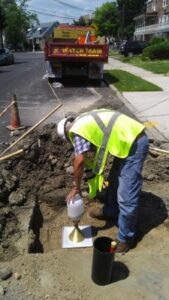When driving in NYC it is common to experience a bumpy ride due to large potholes and defective roadways. The NYC DOT enforces special protocol to ensure the integrity of newly paved roadways as a step towards maintaining flush roadways.
If the roadway you live on has been resurfaced or paved over within the previous 5 years, the street is considered a NYC “protected street”. A protected street is a roadway that is still under the NYC DOT 5 year guarantee period; the backfill and restoration process require special attention to protect the roadway after a contractor has completed a new water line or sewer installation.
Protected street requirements include:
- A special NYC DOT permit must be obtained
- All roadway backfills require a “Proctor compaction test” which determines the moisture and density levels of the soil being used to fill the hole.
- A saw cut must be performed around the entire hole in the roadway in preparation for the final restoration of blacktop.
 |

|
The additional cost associated when opening a protected street stems from the NYC DOT (Department of Transportation) permits fees, compaction testing and the roadway restoration requirements. The additional cost may range from $100 – $900 pending the size of the sewer or water main hole that was excavated.
If a street has been paved within the prior 18 months, there are additional requirements and cost associated with the restoration process. The roadway must be paved from the saw cut hole in the roadway to the curb line. This differs from a hole on a roadway that was paved more than 5 years ago, in this case only the hole itself must be paved (no additional DOT requirements).
check here to see if you live on a “protected street” – (list accuracy rate is 95%)
A Brief History on the Proctor Compaction Test
courtesy of Wikipedia
Proctor’s fascination with geotechnical engineering began when taking his undergraduate studies at University of California, Berkeley. He was interested in the publications of Sir Alec Skempton and his ideas on in situ behavior of natural clays. Skempton formulated concepts and porous water coefficients that are still widely used today. It was Proctor’s idea to take this concept a step further and formulate his own experimental conclusions to determine a solution for the in situ behaviors of clay and ground soils that cause it to be unsuitable for construction. His idea, which was later adopted and expounded upon by Skempton, involved the compaction of the soil to establish the maximum practically-achievable density of soils and aggregates (the “practically” stresses how the value is found experimentally and not theoretically).
In the early 1930s, he finally created a solution for determining the maximum density of soils. He found that in a controlled environment (or within a control volume), the soil could be compacted to the point where the air could be completely removed, simulating the effects of a soil in situ conditions. From this, the dry density could be determined by simply measuring the weight of the soil before and after compaction, calculating the moisture content, and furthermore calculating the dry density. Ralph R. Proctor went on to teach at the University of Arkansas.
In 1958, the modified Proctor compaction test was developed as an ASTM standard. A higher and more relevant compaction standard was necessary. There were larger and heavier compaction equipment, like large vibratory compactors and heavier steam rollers. This equipment could produce higher dry densities in soils along with greater stability. These improved properties allowed for the transport of far heavier truck loads over roads and highways. During the 1970s and early 1980s the modified Proctor test became more widely used as a modern replacement for the standard Proctor test.[2] Theory of Soil compaction
Compaction is the process by which the bulk density of an aggregate of matter is increased by driving out air. For any soil, for a given amount of compactive effort, the density obtained depends on the moisture content. At very high moisture contents, the maximum dry density is achieved when the soil is compacted to nearly saturation, where (almost) all the air is driven out. At low moisture contents, the soil particles interfere with each other; addition of some moisture will allow greater bulk densities, with a peak density where this effect begins to be counteracted by the saturation of the soil. Comparison of tests
The original Proctor test, ASTM D698 / AASHTO T99, uses a 4-inch-diameter (100 mm) mould which holds 1/30th cubic foot of soil, and calls for compaction of three separate lifts of soil using 25 blows by a 5.5 lb hammer falling 12 inches, for a compactive effort of 12,400 ft. The “Modified Proctor” test, ASTM D1557 / AASHTO T180, uses same mould, but uses a 10 lb. hammer falling through 18 inches, with 25 blows on each of five lifts, for a compactive effort of about 56,000 ft-lbf/ft³. Both tests allow the use of a larger mould, 6 inches in diameter and holding 1/13.333 ft³, if the soil or aggregate contains too large a proportion of gravel-sized particles to allow repeatability with the 4-inch mould. To ensure the same compactive effort, the number of blows per lift is increased to 56.




















